hyperthyroidism support
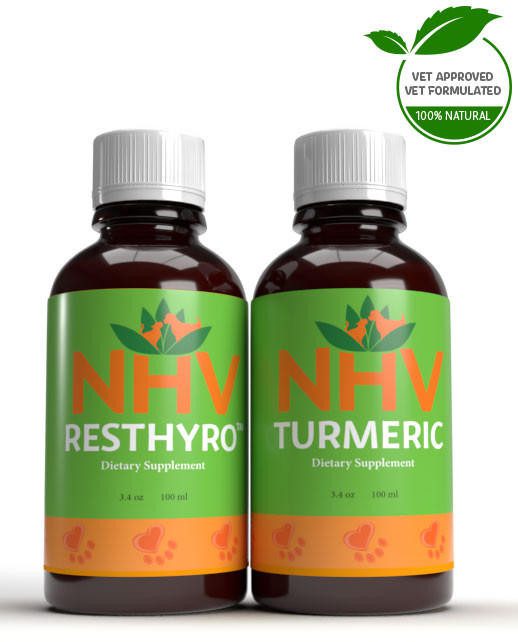
free shipping over $100 (USA & Canada)
1-877-937-4372 the pet expert hotline

Natural Support for Hyperthyroidism in Cats & Pets

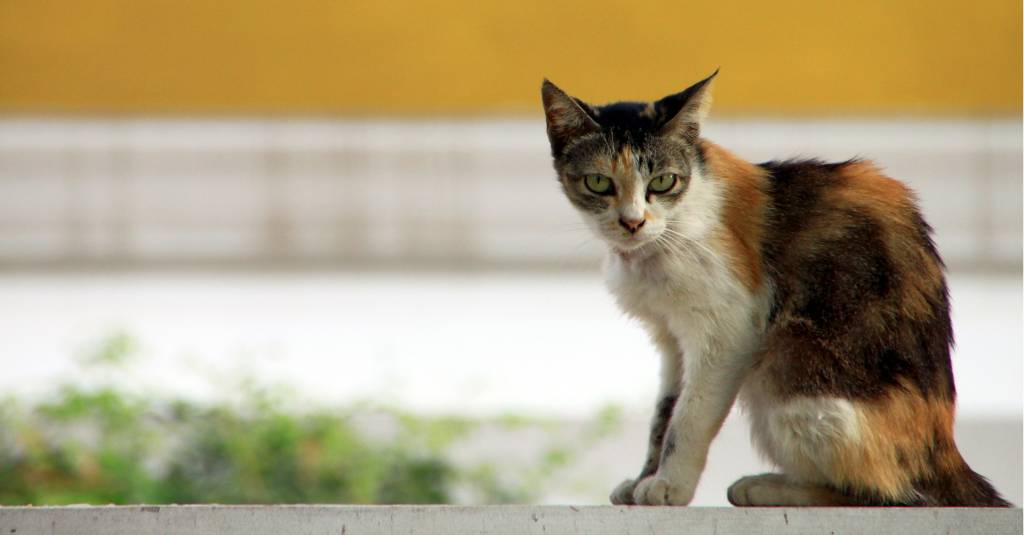
Feline hyperthyroidism was first diagnosed in 1979. Since then, it has been increasingly diagnosed, becoming an important and common endocrinopathy in elderly cats. While dogs suffer more from hypothyroidism, cats are more likely to suffer from hyperthyroidism. It occurs in about 10% of cats over 10 years of age.
Feline hyperthyroidism is an endocrine syndrome resulting from high levels of thyroid hormone (T4) present in the circulation due to an abnormal functioning of the thyroid gland that secretes excess thyroid hormone. In most cases, hyperthyroidism results from adenomatous hyperplasia or thyroid adenoma, which leads to an increase in the production of thyroid gland hormones. Cats typically have two thyroid glands, and hyperthyroidism may affect one or both.
When the veterinarian examines the cat, an enlarged thyroid gland may be felt at the level of the throat, under the cat’s chin.
If your veterinarian diagnoses your cat with hyperthyroidism, it means your cat has an excess of a hormone that causes an overactive metabolism. This can stress the heart, digestive tract, and many other organ systems. Your cat may show symptoms such as weight loss despite normal or increased appetite, increased urination, increased drinking or thirst, hyperactivity, vomiting, abnormal breathing (due to cardiac issues), diarrhea, increased fecal volume, weakness, behavioral changes, and poor hair coat. If you notice these symptoms, it’s important to seek treatment for your cat to control the condition.
The diagnosis of hyperthyroidism is based on history and clinical findings and is confirmed by increased serum concentration of T4. Routine tests may detect high blood concentrations of T4 before owners notice clinical signs. When the veterinarian examines the cat, they may feel the enlarged thyroid at the level of the throat, under the cat’s chin.
During the physical examination, signs such as loss of muscle mass, hypertension, and increased heart and respiratory rates may be observed. It may be necessary to conduct a comprehensive screening of other organs, such as the kidneys, liver, and heart because hyperthyroidism can occur alongside other medical conditions.
The treatment of hyperthyroidism is multimodal. After the diagnosis, treatment involves controlling excessive thyroid hormone secretion, and symptoms associated with the condition. Your primary veterinarian will guide you through medical and surgical treatment for the primary disease. They may recommend thyroid medication, surgery, and radioactive iodine. The use of different types of treatments and support is sometimes necessary, including natural supplements and dietary changes.
The NHV Hyperthyroidism Gold Support Kit includes RESTHYRO and TURMERIC, and it is designed to provide natural support for cats experiencing symptoms of hyperthyroidism. It can be used in conjunction with vet-prescribed treatment.
NHV RESTHYRO is formulated with a combination of herbs known to help control thyroid hormone production and support heart, circulatory, and kidney function, which may be affected by accelerated metabolism caused by hyperthyroidism. It may also help regulate appetite, food metabolism, weight management, relieve tension and irritability (yowling), and reduce thirst and urination.
TURMERIC contains curcumin, a powerful antioxidant with benefits for discomfort and inflammation. Research has shown that it supports heart health, helps with hypertension, lowers bad cholesterol, and supports the function of both the heart and liver. It also helps improve the quality of the skin and coat.
The successful nutritional management of hyperthyroidism relies heavily on the efficacy of the medical and surgical treatment of the underlying condition. It is generally sufficient to provide commercially available moist, semi-moist, and dry foods that align with the specific nutrient requirements for adult maintenance.
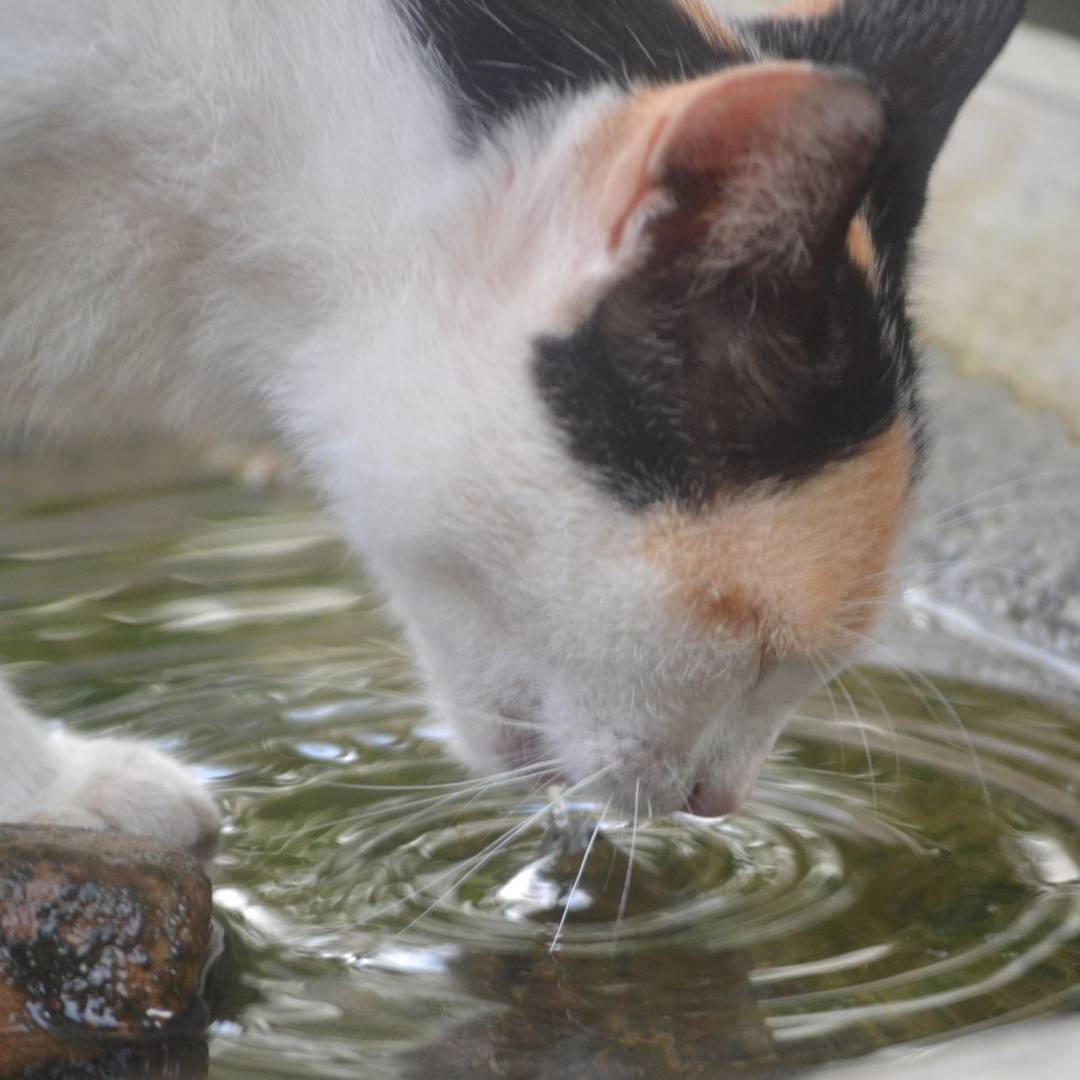
Ensuring adequate water intake is crucial for all cats, with particular importance for hyperthyroid cats due to their elevated metabolic rate. This heightened metabolic rate can result in increased water intake and subsequent water loss through urine. It is essential to provide continuous access to fresh water. Additionally, incorporating wet food into their diet can be advantageous as it promotes increased water consumption.
Hyperthyroid cats often exhibit an elevated metabolic rate, resulting in weight loss despite an increased appetite. Consequently, if caretakers effectively manage the condition, dietary adjustments are unnecessary at this point. Your veterinarian should determine the optimal body weight for ongoing monitoring of the outcomes.
Muscle loss is a prominent concern in hyperthyroid felines due to heightened metabolic activity. It is essential to provide adequate high-quality protein to mitigate muscle loss and sustain overall feline health. Diets should encompass elevated levels of easily digestible protein to ensure the preservation of the cat’s muscle mass. However, hyperthyroidism is commonly linked to kidney malfunction; hence, it is imperative to exclude renal insufficiency before administering high-protein diets.
Cats with hyperthyroidism exhibit reduced fat stores due to their heightened metabolic state. The primary disease must be promptly addressed. A diet meeting specific nutritional guidelines for their age is crucial for the swift restoration of normal body weight. In cases of severe body mass wasting, it is imperative to increase the calorie content of their food to promote weight gain.
Fiber: Incorporating a moderate amount of fiber into a diet can be advantageous. However, excessive fiber intake may impede the absorption of nutrients.
When managing hyperthyroidism in felines, it is crucial to understand that the process encompasses more than simply dietary considerations. This complex condition necessitates professional veterinary oversight and regular monitoring.
Feeding small amounts multiple times per day may be necessary during recovery. Two daily feedings are sufficient once an animal resumes normal eating behavior. Engage with a veterinarian to develop a comprehensive treatment regimen tailored to your cat’s specific requirements. NHV offers a personalized nutrition plan that can help you plan a new diet for your pet.
hyperthyroidism support

Natural Support for Hyperthyroidism in Cats & Pets
bundle and save with pet expert kits
3 month supply for a small to medium size pet
What is it?
A complete kit to support your pet through symptoms of hyperthyroidism.
How Does it Work?
Why Should I Trust It?
Safe to use long-term, vet-formulated, and vet-approved.

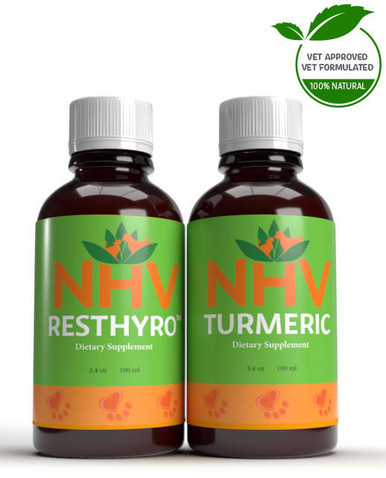
What is it?
A complete kit to support your pet through symptoms of hyperthyroidism.
How Does it Work?
Why Should I Trust It?
Safe to use long-term, vet-formulated, and vet-approved.

This supplement has been formulated combining several different herbs that are known to help control thyroid hormone production, and support heart circulatory and kidney function.
When using supplements to support hyperthyroidism it is important that the organs most affected by the condition are supported as well. Turmeric contains curcumin, which is a powerful antioxidant that makes it beneficial for discomfort and inflammation. Research has found that it is a powerful herb for heart health. It helps with hypertension, lowers bad cholesterol and supports both the heart and liver function. It is also beneficial in aiding digestion and diarrhea in cats and dogs.
Natural Support and can be used in conjunction with Vet-Prescribed Treatment of Hyperthyroidism in Cats
Hyperthyroidism is a common condition seen in middle-aged to older cats. This condition is exceedingly rare in dogs. Hyperthyroidism is caused when there is an overproduction of thyroid hormones T3 and T4. As the thyroid hormones control the function of nearly all the organs, it is common to see secondary health conditions such as heart disease, hypertension, and kidney disease.
With NHV’s Hyperthyroidism Gold Support Kit, you will get an effective blend of herbs that are safe to use long-term and are vet-recommended natural treatments for hyperthyroidism in cats. Find out how Penny improved her quality of life with NHV’s plant-based products.
Read more about hyperthyroidism medicine for cats on our blog at Vet Talk with Dr. Hillary Cook, because at NHV we want to support pet parents to help their fur babies in every way possible.
NHV’s Hyperthyroidism Gold Support Kit contains two potent blends of vet-formulated herbal supplements that may help support your cat’s thyroid as well as the overall function of the thyroid gland.
1.NHV’s Resthyro — A powerful blend of herbs that help control thyroid function as well as supporting heart circulation and kidney function make this a great additional support as well as being a vet-recommended natural support for hyperthyroidism in cats.
2.NHV’s Turmeric — A potent antioxidant and anti-inflammatory that contains curcumin, which is highly effective for discomfort and inflammation. This herb also aids in
Select your pet's weight to determine the correct dose.
To be taken twice daily. Determine your pet’s weight and then use the easy chart below to determine the correct dose. This is the minimum dosage.
Pet's Weight Dosage
0 - 15 lb = 0.5 ml
16 - 30 lb = 1.0 ml
31 - 45 lb = 1.5 ml
46 - 60 lb = 2.0 ml
61 - 75 lb = 2.5 ml
Over 75 lb = 3.0 ml
For small animals (rabbits, ferrets), avians and reptiles use 1 drop for every 2 lb of body weight.
How to Administer
Shake well before use. The easiest method is to use the dropper provided and place the drops into your pet’s food or favorite treat. You can also use the dropper and squirt directly into the pet’s mouth. Some pets can be finicky, if this occurs consider hiding the drops in foods most pet’s love such as fish, chicken or yogurt or a favorite treat. If your pet only eats dry food then soak a few kibbles at feeding time.
For Best Results
Herbal dietary supplements are beneficial to the health and well-being of your pet and are safe for long-term use. Every pet responds to natural herbal supplements differently, therefore it is important to be consistent and administer the product daily. Supplements generally take two to four weeks to take effect, however this will vary from one animal to the next.
Product Storage
All NHV Natural Pet Products are pure herbal extracts and contain no artificial additives, preservatives or coloring. Shelf life after opening is 6 months and must be refrigerated after opening.
Cautions and Contraindications
Do not use in pregnant or nursing animals.
All information provided by NHV Natural Pet Products is for educational purposes only.
This supplement has been formulated combining several different herbs that are known to help control thyroid hormone production, and support heart circulatory and kidney function.
When using supplements to support hyperthyroidism it is important that the organs most affected by the condition are supported as well. Turmeric contains curcumin, which is a powerful antioxidant that makes it beneficial for discomfort and inflammation. Research has found that it is a powerful herb for heart health. It helps with hypertension, lowers bad cholesterol and supports both the heart and liver function. It is also beneficial in aiding digestion and diarrhea in cats and dogs.
Natural Support and can be used in conjunction with Vet-Prescribed Treatment of Hyperthyroidism in Cats
Hyperthyroidism is a common condition seen in middle-aged to older cats. This condition is exceedingly rare in dogs. Hyperthyroidism is caused when there is an overproduction of thyroid hormones T3 and T4. As the thyroid hormones control the function of nearly all the organs, it is common to see secondary health conditions such as heart disease, hypertension, and kidney disease.
With NHV’s Hyperthyroidism Gold Support Kit, you will get an effective blend of herbs that are safe to use long-term and are vet-recommended natural treatments for hyperthyroidism in cats. Find out how Penny improved her quality of life with NHV’s plant-based products.
Read more about hyperthyroidism medicine for cats on our blog at Vet Talk with Dr. Hillary Cook, because at NHV we want to support pet parents to help their fur babies in every way possible.
NHV’s Hyperthyroidism Gold Support Kit contains two potent blends of vet-formulated herbal supplements that may help support your cat’s thyroid as well as the overall function of the thyroid gland.
1.NHV’s Resthyro — A powerful blend of herbs that help control thyroid function as well as supporting heart circulation and kidney function make this a great additional support as well as being a vet-recommended natural support for hyperthyroidism in cats.
2.NHV’s Turmeric — A potent antioxidant and anti-inflammatory that contains curcumin, which is highly effective for discomfort and inflammation. This herb also aids in
Select your pet's weight to determine the correct dose.
To be taken twice daily. Determine your pet’s weight and then use the easy chart below to determine the correct dose. This is the minimum dosage.
Pet's Weight Dosage
0 - 15 lb = 0.5 ml
16 - 30 lb = 1.0 ml
31 - 45 lb = 1.5 ml
46 - 60 lb = 2.0 ml
61 - 75 lb = 2.5 ml
Over 75 lb = 3.0 ml
For small animals (rabbits, ferrets), avians and reptiles use 1 drop for every 2 lb of body weight.
How to Administer
Shake well before use. The easiest method is to use the dropper provided and place the drops into your pet’s food or favorite treat. You can also use the dropper and squirt directly into the pet’s mouth. Some pets can be finicky, if this occurs consider hiding the drops in foods most pet’s love such as fish, chicken or yogurt or a favorite treat. If your pet only eats dry food then soak a few kibbles at feeding time.
For Best Results
Herbal dietary supplements are beneficial to the health and well-being of your pet and are safe for long-term use. Every pet responds to natural herbal supplements differently, therefore it is important to be consistent and administer the product daily. Supplements generally take two to four weeks to take effect, however this will vary from one animal to the next.
Product Storage
All NHV Natural Pet Products are pure herbal extracts and contain no artificial additives, preservatives or coloring. Shelf life after opening is 6 months and must be refrigerated after opening.
Cautions and Contraindications
Do not use in pregnant or nursing animals.
All information provided by NHV Natural Pet Products is for educational purposes only.
hyperthyroidism support
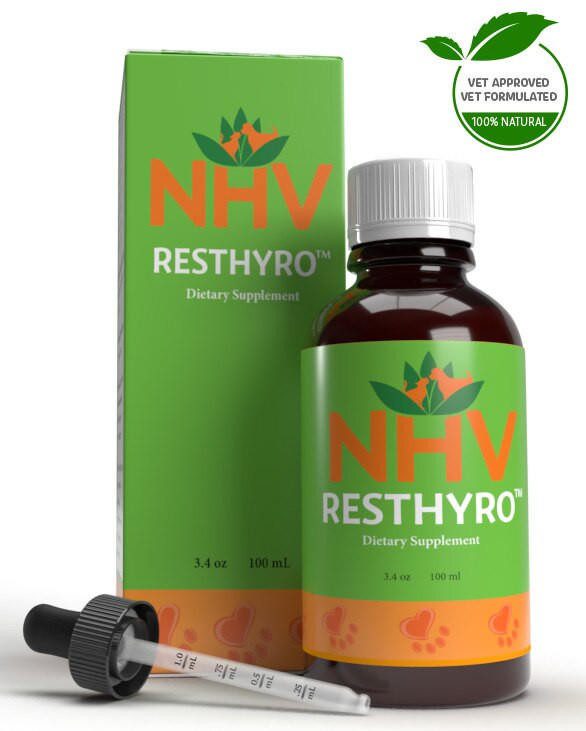
Support for Hyperthyroidism in Cats
buy 2 and save $3
3 month supply for a small to medium size
What is it?
A vet-formulated feline hyperthyroidism remedy designed to help balance thyroid function, as well as manage secondary feline hyperthyroidism symptoms.
How does it work?
Why trust it?
NHV Resthyro has helped cats around the world, like Penny, who has hyperthyroidism.
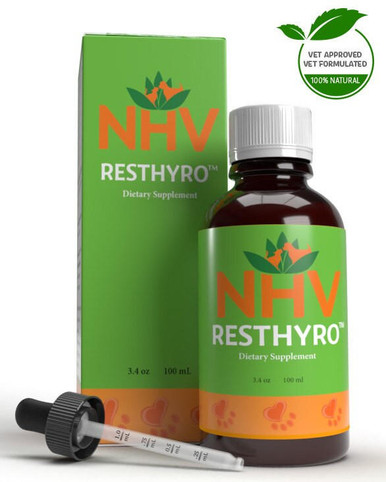
What is it?
A vet-formulated feline hyperthyroidism remedy designed to help balance thyroid function, as well as manage secondary feline hyperthyroidism symptoms.
How does it work?
Why trust it?
NHV Resthyro has helped cats around the world, like Penny, who has hyperthyroidism.
NHV Resthyro™ feline hyperthyroidism remedy is made with quality herbs that are formulated to work together to support the balance of your cat’s thyroid function, support the organs affected by hyperthyroidism, and support feline hyperthyroidism symptoms. This formula has helped to support feline hyperthyroidism, for thousands of pets across the world!
Resthyro™ was formulated by a holistic veterinarian and a master herbalist with a combined 50 years of experience treating pets. It’s made using powerful herbs such as eleuthero, bugleweed, lemon balm, and gotu kola. Together, these and other ingredients help to balance thyroid hormones in your pet’s body. They help your pet’s blood pressure healthier and promote better management of stress. As a feline hyperthyroidism remedy, this supplement can be taken alongside your vet’s prescribed medication to provide comprehensive support.
Hyperthyroidism in cats is caused by excess production of thyroid hormones (T3 and T4). One of the most common causes of feline hyperthyroidism is a hormone-producing benign tumor. Most cases of cats with hyperthyroidism are older pets (generally over 10 years of age).
Cats with symptoms of feline hyperthyroidism may also experience secondary problems such as mild liver, kidney, or heart disease.
NHV supplements include multiple all-natural remedies for feline hyperthyroidism. If your cat is experiencing liver problems, we suggest NHV Milk Thistle; for kidney issues, we suggest NHV Tripsy; and for heart conditions, we suggest combining NHV Hearty Heart with Resthyro™.
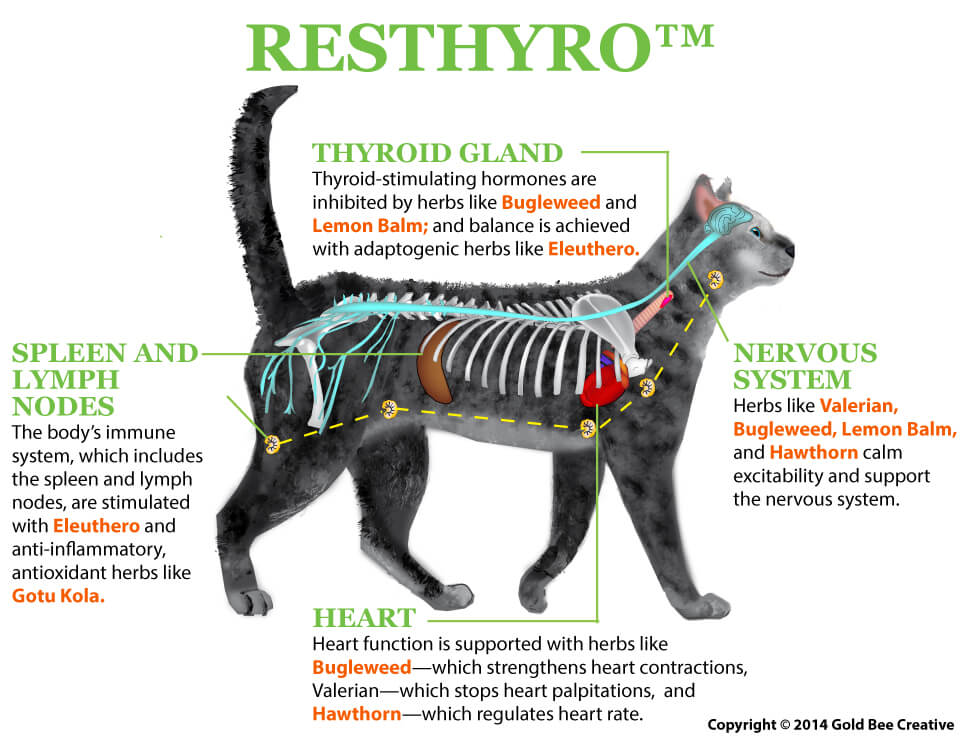
Eleuthero – Helps to balance the thyroid, stimulates the immune system, and helps to improve resistance to stress.
Bugleweed – Helps to reduce thyroid hormones in the body. It also slows and strengthens heart contractions. Relieves tension and irritability, and acts as a cough suppressant.
Lemon Balm – Inhibits thyroid activity by blocking thyroid-stimulating hormones. Also found to reduce stress, decrease blood pressure, and improve gastrointestinal activity.
Gotu Kola – A small green herb known for its cleansing abilities and used to treat skin problems. It also has strong antioxidant, antibacterial, and anti-inflammatory properties.
Hawthorn – Helps strengthen and improve heart function.
Skullcap – Known for its relaxing and detoxifying qualities, as well as its ability to stimulate kidney function.
Valerian – Well known for its use in the treatment of anxiety, and has been used extensively as a mild sedative and pain reliever.
Select your pet's weight to determine the correct dose.
To be taken twice daily. Determine your pet’s weight and then use the easy chart below to determine the correct dose. This is the minimum dosage.
Pet's Weight Dosage
0 - 15 lb = 0.5 ml
16 - 30 lb = 1.0 ml
31 - 45 lb = 1.5 ml
46 - 60 lb = 2.0 ml
61 - 75 lb = 2.5 ml
Over 75 lb = 3.0 ml
How to Administer
Shake well before use. The easiest method is to use the dropper provided and place the drops into your pet’s food or favorite treat. You can also use the dropper and squirt directly into the pet’s mouth.
Some pets can be finicky, if this occurs consider hiding the drops in foods most pet’s love such as fish, chicken or yogurt or a favourite treat. If your pet only eats dry food then soak a few kibbles at feeding time.
For Best Results
Herbal dietary supplements are beneficial to the health and well-being of your pet and are safe for long-term use. Every pet responds to natural herbal supplements differently, therefore it is important to be consistent and administer the product daily. Supplements generally take two to four weeks to take effect, however this will vary from one animal to the next.
Product Storage
All NHV Natural Pet Products are pure herbal extracts and contain no artificial additives, preservatives or coloring. Shelf life after opening is 6 months and must be refrigerated after opening.
Cautions and Contraindications
Do not use Resthyro™ in pregnant or nursing animals. Should not be used in animals with hypothyroidism (under active thyroid gland). Speak to your vet before using our products. A second visit is recommended if your pet’s condition does not improve, or deteriorates after continued use of the supplements.
All information provided by NHV Natural Pet Products is for educational purposes only.
NHV Resthyro™ feline hyperthyroidism remedy is made with quality herbs that are formulated to work together to support the balance of your cat’s thyroid function, support the organs affected by hyperthyroidism, and support feline hyperthyroidism symptoms. This formula has helped to support feline hyperthyroidism, for thousands of pets across the world!
Resthyro™ was formulated by a holistic veterinarian and a master herbalist with a combined 50 years of experience treating pets. It’s made using powerful herbs such as eleuthero, bugleweed, lemon balm, and gotu kola. Together, these and other ingredients help to balance thyroid hormones in your pet’s body. They help your pet’s blood pressure healthier and promote better management of stress. As a feline hyperthyroidism remedy, this supplement can be taken alongside your vet’s prescribed medication to provide comprehensive support.
Hyperthyroidism in cats is caused by excess production of thyroid hormones (T3 and T4). One of the most common causes of feline hyperthyroidism is a hormone-producing benign tumor. Most cases of cats with hyperthyroidism are older pets (generally over 10 years of age).
Cats with symptoms of feline hyperthyroidism may also experience secondary problems such as mild liver, kidney, or heart disease.
NHV supplements include multiple all-natural remedies for feline hyperthyroidism. If your cat is experiencing liver problems, we suggest NHV Milk Thistle; for kidney issues, we suggest NHV Tripsy; and for heart conditions, we suggest combining NHV Hearty Heart with Resthyro™.

Eleuthero – Helps to balance the thyroid, stimulates the immune system, and helps to improve resistance to stress.
Bugleweed – Helps to reduce thyroid hormones in the body. It also slows and strengthens heart contractions. Relieves tension and irritability, and acts as a cough suppressant.
Lemon Balm – Inhibits thyroid activity by blocking thyroid-stimulating hormones. Also found to reduce stress, decrease blood pressure, and improve gastrointestinal activity.
Gotu Kola – A small green herb known for its cleansing abilities and used to treat skin problems. It also has strong antioxidant, antibacterial, and anti-inflammatory properties.
Hawthorn – Helps strengthen and improve heart function.
Skullcap – Known for its relaxing and detoxifying qualities, as well as its ability to stimulate kidney function.
Valerian – Well known for its use in the treatment of anxiety, and has been used extensively as a mild sedative and pain reliever.
Select your pet's weight to determine the correct dose.
To be taken twice daily. Determine your pet’s weight and then use the easy chart below to determine the correct dose. This is the minimum dosage.
Pet's Weight Dosage
0 - 15 lb = 0.5 ml
16 - 30 lb = 1.0 ml
31 - 45 lb = 1.5 ml
46 - 60 lb = 2.0 ml
61 - 75 lb = 2.5 ml
Over 75 lb = 3.0 ml
How to Administer
Shake well before use. The easiest method is to use the dropper provided and place the drops into your pet’s food or favorite treat. You can also use the dropper and squirt directly into the pet’s mouth.
Some pets can be finicky, if this occurs consider hiding the drops in foods most pet’s love such as fish, chicken or yogurt or a favourite treat. If your pet only eats dry food then soak a few kibbles at feeding time.
For Best Results
Herbal dietary supplements are beneficial to the health and well-being of your pet and are safe for long-term use. Every pet responds to natural herbal supplements differently, therefore it is important to be consistent and administer the product daily. Supplements generally take two to four weeks to take effect, however this will vary from one animal to the next.
Product Storage
All NHV Natural Pet Products are pure herbal extracts and contain no artificial additives, preservatives or coloring. Shelf life after opening is 6 months and must be refrigerated after opening.
Cautions and Contraindications
Do not use Resthyro™ in pregnant or nursing animals. Should not be used in animals with hypothyroidism (under active thyroid gland). Speak to your vet before using our products. A second visit is recommended if your pet’s condition does not improve, or deteriorates after continued use of the supplements.
All information provided by NHV Natural Pet Products is for educational purposes only.
arthritis support
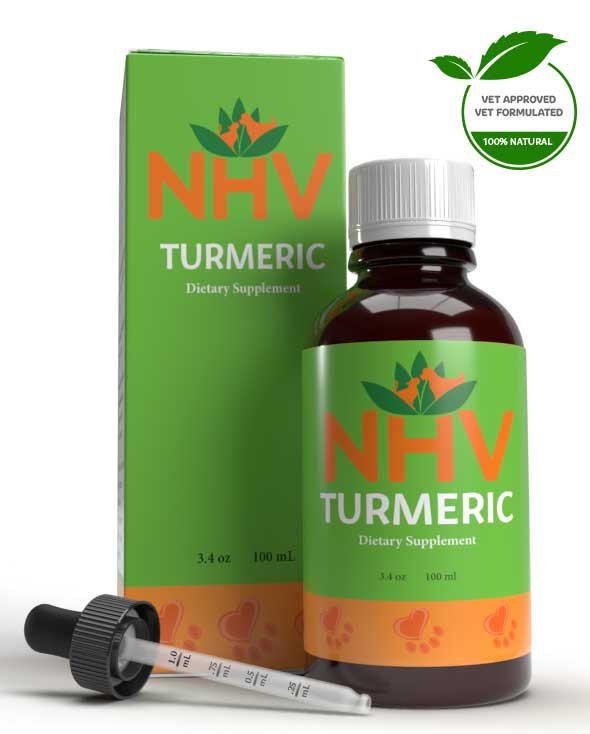
Support for Arthritis and Cancer
buy 2 and save $3
3 month supply for a small to medium size
What is it?
Turmeric is an herb that offers support for cardiovascular issues, skin health, liver and kidney disease, arthritis, and overall well-being.
How does it work?
Why trust it?
NHV Turmeric is vet-formulated and vet-approved.
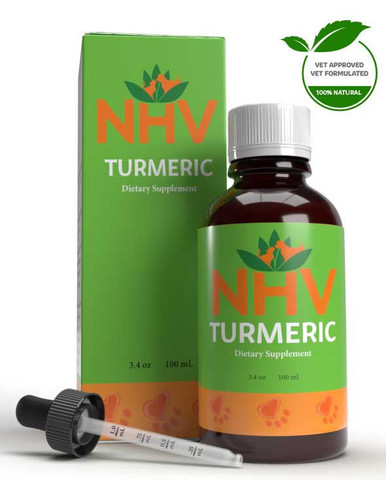
What is it?
Turmeric is an herb that offers support for cardiovascular issues, skin health, liver and kidney disease, arthritis, and overall well-being.
How does it work?
Why trust it?
NHV Turmeric is vet-formulated and vet-approved.
From their tails to their whiskers, a cat’s body needs to be able to fight whatever comes their way - and not just the toys they like to chase, but health concerns too. NHV Turmeric for cats can be given to your furkiddos for a little extra TLC. It’s well-tolerated by our whiskered furkiddos, and can offer them many benefits!
What goes into your cat’s body every day will make a difference when it is time to fight a disease, or when they already have one. That’s why NHV supplements are designed to be given each and every day for things like:
It can even be used proactively before your furry friend becomes sick in the first place by giving them a regular boost of natural goodness!
Turmeric itself is a root with vibrant orange-golden flesh. It’s golden in the world of herbalism for pets with its many healing properties.
One of turmeric’s most well-recognized healing properties is its antioxidant content. Antioxidants can help scavenge for free radicals, which are unstable molecules that cause damage to the cells. The free radical scavenging properties of turmeric can support the body in processing and removing these molecules, minimizing the damage they can do.
At NHV, we are experts at harnessing the benefits of herbal ingredients specifically for your pets. When you choose NHV Turmeric, you’re choosing decades of holistic pet wellness experience from vets and herbalists. Our formula is:
We are proud to have been a part of many cats’ success stories over the decades. Check out this feline friend of ours, Willow, who has used our Turmeric for cats formula for comfort and wellness.
Willow’s Story: “I have no doubt that the supplements from NHV have been a huge part in maintaining her health and staving off the cancer that was found in late 2021”
Holistic Veterinarian Approves of Using Turmeric for Cats
Dr. Hillary, a holistic vet, writes an in-depth overview of Turmeric and why she believes turmeric can play a beneficial role in pet health. Read Dr. Hillary’s Turmeric overview here.
All NHV supplements are made with the finest quality organic or ethically harvested herbs. We use non-GMO vegetable glycerin as our base. NHV products are full-spectrum extracts.
Select your pet's weight to determine the correct dose.
To be taken twice daily. Determine your pet’s weight and then use the easy chart below to determine the correct dose. This is the minimum dosage.
Pet's Weight Dosage
0 - 15 lb = 0.5 ml
16 - 30 lb = 1.0 ml
31 - 45 lb = 1.5 ml
46 - 60 lb = 2.0 ml
61 - 75 lb = 2.5 ml
Over 75 lb = 3.0 ml
How to Administer
Shake well before use. The easiest method is to use the dropper provide and places the drops into your pet’s food or favorite treat. You can also use the dropper and squirt directly into the pet’s mouth.
Some pets can be finicky, if this occurs consider hiding the drops in foods most pet’s love such as fish, chicken or yogurt or a favourite treat. If your pet only eats dry food then soak a few kibbles at feeding time.
For Best Results
Herbal dietary supplements are beneficial to the health and wellbeing of your pet and are safe for long-term use. Every pet responds to natural herbal supplements differently, therefore it is important to be consistent and administer the product daily. Supplements generally take two to four weeks to take effect, however this will vary from one animal to the next.
Product Storage
All NHV Natural Pet Products are pure herbal extracts and contain no artificial additives, preservatives or coloring. Shelf life after opening is 6 months and must be refrigerated after opening.
Cautions and Contraindications: Do not use Turmeric in pregnant or nursing animals. Speak to your vet before using our products. A second visit is recommended if your pet’s condition does not improve, or deteriorates after continued use of the supplements.
From their tails to their whiskers, a cat’s body needs to be able to fight whatever comes their way - and not just the toys they like to chase, but health concerns too. NHV Turmeric for cats can be given to your furkiddos for a little extra TLC. It’s well-tolerated by our whiskered furkiddos, and can offer them many benefits!
What goes into your cat’s body every day will make a difference when it is time to fight a disease, or when they already have one. That’s why NHV supplements are designed to be given each and every day for things like:
It can even be used proactively before your furry friend becomes sick in the first place by giving them a regular boost of natural goodness!
Turmeric itself is a root with vibrant orange-golden flesh. It’s golden in the world of herbalism for pets with its many healing properties.
One of turmeric’s most well-recognized healing properties is its antioxidant content. Antioxidants can help scavenge for free radicals, which are unstable molecules that cause damage to the cells. The free radical scavenging properties of turmeric can support the body in processing and removing these molecules, minimizing the damage they can do.
At NHV, we are experts at harnessing the benefits of herbal ingredients specifically for your pets. When you choose NHV Turmeric, you’re choosing decades of holistic pet wellness experience from vets and herbalists. Our formula is:
We are proud to have been a part of many cats’ success stories over the decades. Check out this feline friend of ours, Willow, who has used our Turmeric for cats formula for comfort and wellness.
Willow’s Story: “I have no doubt that the supplements from NHV have been a huge part in maintaining her health and staving off the cancer that was found in late 2021”
Holistic Veterinarian Approves of Using Turmeric for Cats
Dr. Hillary, a holistic vet, writes an in-depth overview of Turmeric and why she believes turmeric can play a beneficial role in pet health. Read Dr. Hillary’s Turmeric overview here.
All NHV supplements are made with the finest quality organic or ethically harvested herbs. We use non-GMO vegetable glycerin as our base. NHV products are full-spectrum extracts.
Select your pet's weight to determine the correct dose.
To be taken twice daily. Determine your pet’s weight and then use the easy chart below to determine the correct dose. This is the minimum dosage.
Pet's Weight Dosage
0 - 15 lb = 0.5 ml
16 - 30 lb = 1.0 ml
31 - 45 lb = 1.5 ml
46 - 60 lb = 2.0 ml
61 - 75 lb = 2.5 ml
Over 75 lb = 3.0 ml
How to Administer
Shake well before use. The easiest method is to use the dropper provide and places the drops into your pet’s food or favorite treat. You can also use the dropper and squirt directly into the pet’s mouth.
Some pets can be finicky, if this occurs consider hiding the drops in foods most pet’s love such as fish, chicken or yogurt or a favourite treat. If your pet only eats dry food then soak a few kibbles at feeding time.
For Best Results
Herbal dietary supplements are beneficial to the health and wellbeing of your pet and are safe for long-term use. Every pet responds to natural herbal supplements differently, therefore it is important to be consistent and administer the product daily. Supplements generally take two to four weeks to take effect, however this will vary from one animal to the next.
Product Storage
All NHV Natural Pet Products are pure herbal extracts and contain no artificial additives, preservatives or coloring. Shelf life after opening is 6 months and must be refrigerated after opening.
Cautions and Contraindications: Do not use Turmeric in pregnant or nursing animals. Speak to your vet before using our products. A second visit is recommended if your pet’s condition does not improve, or deteriorates after continued use of the supplements.
Published: July 17, 2024